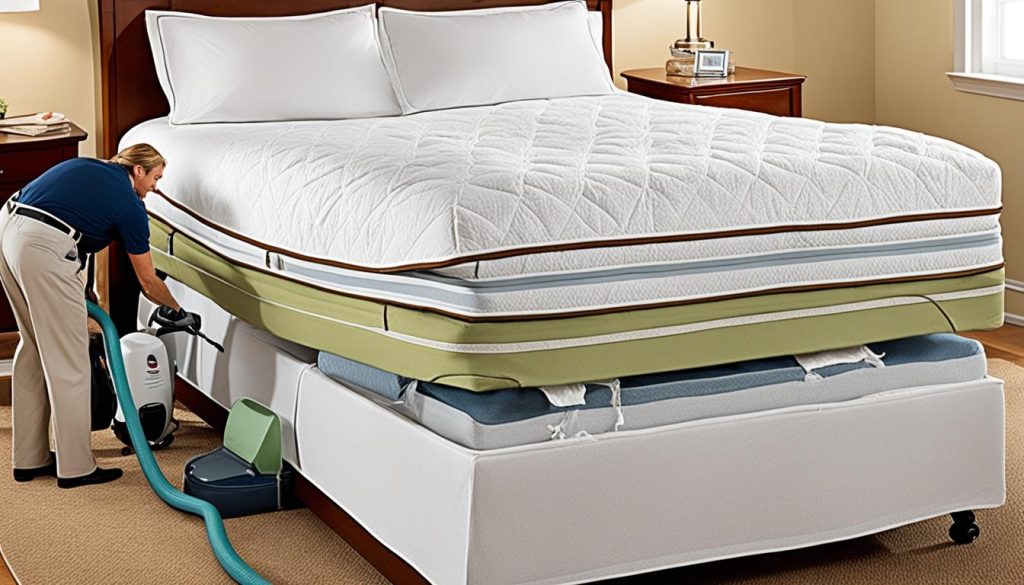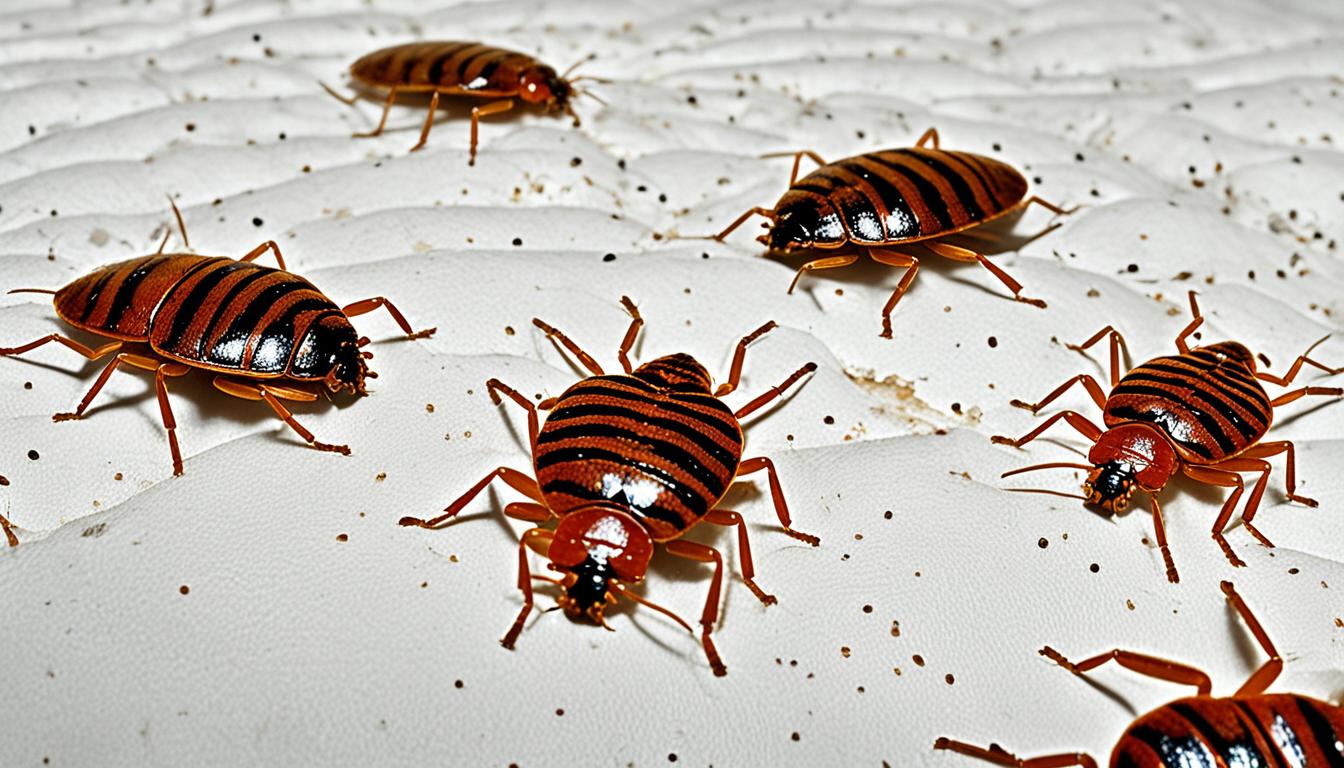Welcome to our guide on bedbugs! We’ll talk about their symptoms, causes, and how to spot infestations. We’ll also discuss treatments, prevention, and some interesting history on these tough bugs. Let’s get started!
Key Takeaways
- Bedbug bites may lead to localized skin reactions or widespread rashes. You might see redness, swelling, and feel intense itching.
- Usually, bedbug bites look like tiny, itchy red bumps. They often have a red circle around the middle.
- To treat bedbug bites, you can apply creams or lotions. These products help reduce itching and redness.
- You can prevent bedbug infestations with regular checks and actions. For example, wash your bedding in hot water often.
- Though bedbugs are bothersome, they don’t significantly spread diseases to humans, as research shows.
Symptoms of Bedbug Bites
Bedbug bites often show up as small, red spots or bumps. People usually feel itchy with these bites. Not everyone feels itchy after a bedbug bite though.
The bites tend to show up in clusters and might have a red ring around them. How long the bites bother someone can differ. For some, the itching and redness lasts a few days. For others, it could last weeks.
Scratching the bites too much might cause scars or infections. It’s best not to scratch. Instead, look for ways to treat the bites.
Signs of Bedbugs
There are signs besides the bites that suggest bedbugs might be around. These signs include:
- Visible bedbugs or their discarded shells
- Small, dark, rust-colored stains on bedding or furniture (from bedbug waste)
- A musty smell in the room
- Tiny blood spots on sheets or pillowcases
If you see any of these signs, you need to act fast. Tackling a bedbug problem early can stop more bites.
| Signs of Bedbug Bites | Symptoms of Bedbugs |
|---|---|
| Small, red welts or bumps | Visible bedbugs or their discarded exoskeletons |
| Itching and redness | Presence of small, dark, and rust-colored stains on bedding or furniture |
| Clusters of bites with a red halo | Musty odor in the affected area |
| Duration of a few days to a couple of weeks | Small blood stains on sheets or pillowcases |
Treatment for Bedbug Bites
If you get bedbug bites, treating them is key to reduce discomfort and avoid problems. There are many ways to deal with bedbug bites effectively.
Topical Creams and Lotions
For bedbug bites, creams or lotions with hydrocortisone are often used. They help by lowering itching and redness. When you apply these creams, they can ease discomfort and help heal.
Preventing Scratching
It’s really important not to scratch bedbug bites, even though they itch. Scratching can make things worse, like causing infections. To avoid scratching, clean the area and use the recommended creams.
Skin Infection Treatment
If bedbug bites lead to a skin infection, you should see a doctor. They might give you antibiotics to get rid of the infection.
Addressing Bedbug Infestation
To stop bedbug bites, you need to take care of the bedbug problem. It’s a good idea to call a pest control expert. They have the right tools and know-how to get rid of bedbugs and stop them from coming back.
Proactive Preventive Measures
To prevent bedbugs, there are steps you can take. Doing regular checks of where you live can catch infestations early. Washing bedding in hot water and using covers on mattresses and pillows can keep bedbugs away.

Comparison of Bedbug Treatment Methods
| Treatment Method | Effectiveness | Advantages | Disadvantages |
|---|---|---|---|
| Topical Creams and Lotions | High | Provides immediate relief | Temporary solution, does not address infestation |
| Professional Pest Control | High | Eliminates infestation | Requires financial investment |
| Regular Inspections | Preventive | Allows early detection | Does not provide immediate relief |
| Using Protective Covers | Preventive | Creates a physical barrier | Does not eliminate existing infestations |
Bedbug Infestation and Transmission of Disease
Bedbug infestations can happen anywhere and don’t depend on how clean a place is. These pests are drawn to our body heat and the carbon dioxide we breathe out. This means any area where people live or spend time can get infested.
Though bedbugs could spread diseases in theory, there’s no hard proof they do it in reality. The chances of getting a disease from bedbugs are quite low. This is for several reasons.
- Lack of Sylvatic Cycles: Bedbugs don’t spread diseases from animals to humans like mosquitoes or ticks might. They mainly feed on human blood and don’t typically feed on animals that carry diseases.
- Limited Exposure to Host Individuals: Bedbugs come out at night and hide during the day close to sleeping areas. They don’t get many chances to spread diseases because they don’t encounter hosts often.
- Hiding Behavior: Preferring to stay out of sight, bedbugs avoid contact with people unless feeding. This secretive behavior lowers disease transmission risks.
Even though bedbugs aren’t likely to make you sick, they can still cause discomfort and stress. It’s important to handle infestations quickly. Taking steps to prevent bedbugs helps keep your home safe and comfortable.
Preventing Bedbug Infestations
Here are some tips to prevent bedbug infestations:
- Check your home often for signs of bedbugs, especially in beds, furniture, and wall cracks.
- Wash and heat-dry your sheets, curtains, and other linens to kill any lurking bedbugs.
- Put protective covers on your mattresses and pillows to keep bedbugs out.
- Declutter your space because bedbugs like to hide in crowded places.
- Look over hotel rooms for bedbugs before you unpack during travels.
- If you think you have bedbugs, call a pest control service right away.
Staying alert and implementing these prevention strategies can vastly lower the chance of a bedbug problem. This ensures your living environment stays peaceful and free of pests.
| Signs of Bedbug Infestation | Preventive Measures |
|---|---|
| Blood stains on sheets or pillowcases | Regularly inspect beds and bedding |
| Dark spots (bedbug feces) on walls, bedding, or furniture | Use protective covers on mattresses and pillows |
| Musty odor in the room | Wash linens and curtains regularly in hot water |
| Visible bedbugs or discarded exoskeletons | Reduce clutter in living spaces |
| Clusters of itchy red bites on the skin | Inspect hotel rooms when traveling |
The History and Evolution of Bedbugs
Bedbugs have always been a nuisance to humans. They likely started as parasites of bats and birds. When humans moved into caves and began farming, our relationship with bedbugs deepened. The first proof of bedbugs with humans appears in ancient Greece in 400 B.C.
Bedbugs have thrived worldwide by targeting different hosts. They resist many pesticides and hide in small spaces. This makes them hard to get rid of.
Over time, bedbugs have adapted to live with us. They love the warmth and food humans provide. They travel with us, infesting places like homes and hotels. Their survival skills have made them a known pest problem.
Effects of the Bedbug Infestation
Bedbug infestations cause more than itchy bites. Infested places deal with stress, lack of sleep, and high costs to fight the bugs.
In recent years, more effort is being put into understanding and stopping bedbugs. Experts are working on better ways to prevent, find, and kill them.
| Period | Key Developments |
|---|---|
| Ancient Greece (400 B.C.) | Earliest recorded evidence of bedbugs infesting human dwellings |
| Middle Ages | Bedbugs prevalent in Europe, infesting beds and causing widespread discomfort |
| 18th and 19th Centuries | Bedbugs introduced to the Americas through European colonization and trade |
| 20th Century | Rise of insecticides leads to a decline in bedbug populations |
| 21st Century | Resurgence of bedbugs due to pesticide resistance, increased travel, and globalization |
The table shows major moments in bedbug history. Understanding this helps us grasp the challenges in controlling them.
Looking ahead, research and new methods are key to fighting bedbugs. Knowing their history and behaviors helps us find better ways to lower their impact on us.
Conclusion
Stem cell therapy doesn’t deal with bedbug issues directly. Yet, it offers great promise for future medical breakthroughs.
Bedbugs may lead to allergic reactions and rashes. Luckily, they don’t spread diseases to humans. Applying creams with hydrocortisone can help soothe bites, easing itching and swelling.
It’s smart to get professional help for bedbugs. Pest control pros know how to get rid of them for good. They use thorough extermination and prevention methods.
To avoid bedbugs, be proactive. Regularly check your sleeping areas, wash your bedding in hot water, and use mattress and pillow covers. Alertness and preventive steps greatly lower the chance of having bedbug problems.

